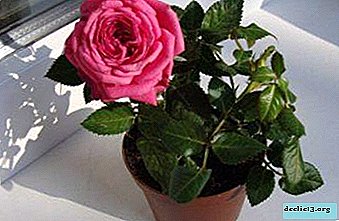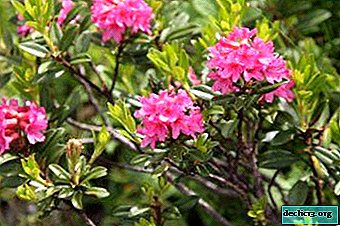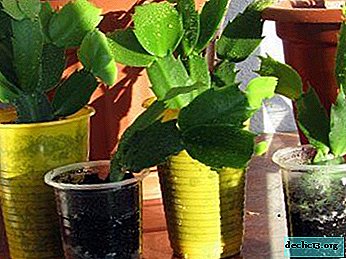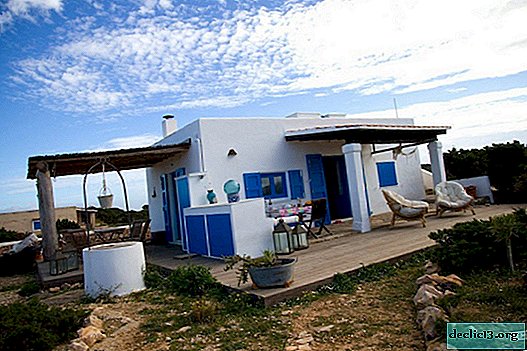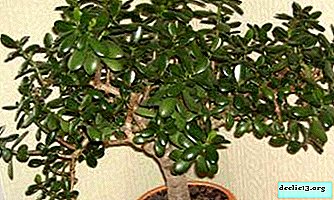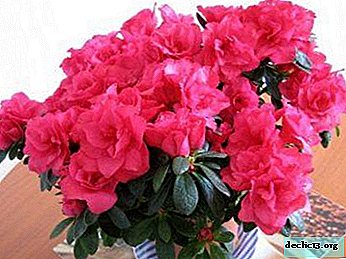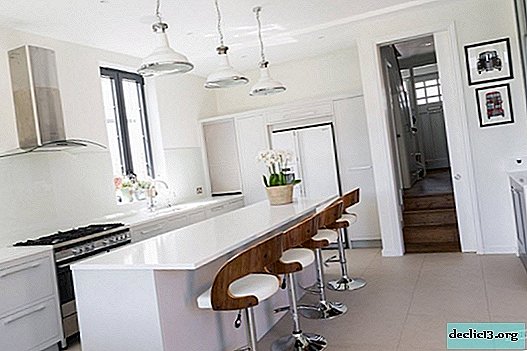Liana in your house: what is an indoor plant climbing anthurium and how to care for it?
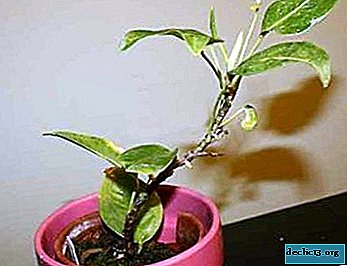
Climbing anthurium belongs to the aroid family. This species, unlike flowering varieties, is popular among flower growers due to its unpretentiousness, evergreen succulent foliage and decorative appearance of fruits.
Flowers at the climbing anthurium do not represent aesthetic value. Attention is drawn to the fruits of anthurium - beautiful berries from white to purple.
In the article, we consider the features and nuances of plant reproduction, and also learn how to properly care for a room flower at home.
Botanical description and photo
This is a perennial, evergreen tropical plant from the genus Anthurium from the aroid family. The Latin name for climbing anthurium is Anthúrium scandens. This species is called evergreen liana. Anthúrium scandens is divided into two subspecies:
- Anthurium scandens subsp. pusillum sheffer;
- Anthurium scandens subsp. scandens.
Appearance:
- Leaves. The leaves are flat with acute grooved petioles, 2 to 8 cm long. The leaf blade is oval or lanceolate-elliptical in shape with a pointed apex. The top of the sheet is glossy, the bottom is covered with black dots.
- Flowers. The flowers are shorter than the leaves, vertical or hanging. The cover of the flower is oval, pale green in color. Pestle is white and green.
- Fruit. Berries are a decoration of a flower. The berries are white, pale purple, sometimes purple in color, ovoid, rounded in the upper part, 3-8 mm wide. Each nest ripens 1-2 seeds. Seeds are light yellow in size 1x2 mm.
The flower was first discovered in 1876 by the French botanist Edward Andre in Ecuador and Colombia. He brought Anthuriums to Europe. Climbing anthurium grows in mountain and piedmont humid tropical forests at an altitude of about 2700 m. In the New World it is the most common species from the aroid family (you can find out what else are the types and varieties of anthurium here).
The native land of this species is South and Central America. The plant is most common in nature in Mexico, El Salvador, Honduras, Guatemala, Nicaragua, Costa Rica. It occurs on the Greater and Lesser Antilles, in Southern Brazil, Venezuela, Colombia, Peru, Bolivia and in other countries with a similar climate. In conditions of the middle band, the climbing species of the plant is grown as an indoor culture.





How to care at home?
- Temperature. Anthurium climbing is an unpretentious species of aroid. He feels comfortable and grows in partial shade at a temperature of 14-25 degrees. The plant is able to tolerate a short-term decrease in temperature to 10 degrees.
- Watering. Throughout the entire life cycle, climbing anthurium requires uniform watering and spraying. Watering should be balanced: it is impossible to allow both overmoistening of the soil and its drying out.
The top layer between waterings should dry completely, otherwise the roots may rot.
If the ambient temperature is too low, then the anthurium should not be watered often and water should be left in the pan. Water for irrigation should be warm and soft (settled, filtered or thawed). The plant responds gratefully to spraying and rubbing the leaves from dust.
- Lighting. Bright lighting is contraindicated for this type, it feels great in partial shade. Direct sunlight can burn the leaves, and they are covered with brown spots. However, the lack of lighting can also negatively affect the anthurium: it can begin to dry out, the leaves are deformed, and the plant stops blooming.
- Priming. The soil composition for climbing anthurium should have a slightly acidic reaction. Often the earthen mixture is made independently. You can make a substrate based on universal soil by adding to it:
- peat;
- sand;
- charcoal;
- coniferous bark;
- moss sphagnum.
Due to this composition, the soil becomes air- and moisture-permeable. A drainage layer is also required. It is allowed to use soil for orchids, where you can add a little sand, charcoal, perlite.
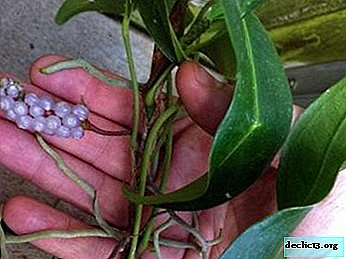 Pruning. If the climbing anthurium has grown too much, then some places need to be cut off. Thus, a healthy compact plant is formed when overgrown with lateral shoots, without weakening flowering and loss of decorativeness. Cut off both shoots and leaves if there are too many of them. But you should not touch the roots - this is the most tender part of the anthurium. They are removed only during transplantation if they are unhealthy.
Pruning. If the climbing anthurium has grown too much, then some places need to be cut off. Thus, a healthy compact plant is formed when overgrown with lateral shoots, without weakening flowering and loss of decorativeness. Cut off both shoots and leaves if there are too many of them. But you should not touch the roots - this is the most tender part of the anthurium. They are removed only during transplantation if they are unhealthy.- Top dressing. The plant has delicate roots and does not like an overabundance of fertilizers, so the recommended rate in the instructions should be halved. Fertilizers for orchids and decorative-flowering plants are suitable for climbing. From spring to autumn, you need to feed the flower every two to three weeks. You can also fertilize with organic matter, for example, mulch the surface of the soil with leaf humus.
- Pot. The pot for anthurium can be clay or plastic. There must be drainage holes at the bottom of the pot. The size of the pot should not be large, otherwise the plant will not grow, and all the energy will be spent on the growth of the root system.
- Transfer. When transplanting an anthurium climbing, like any other, it is necessary to carefully handle fragile roots. The transplant is performed in the following order:
- moisten the soil;
- carefully remove the flower from the old container;
- inspect the roots and remove the sick and damaged;
- lay the drainage layer on the bottom of the pot;
- pour a little substrate on top of the drain;
- place a flower in the center of the flowerpot, and fill the roots with fresh soil, slightly compacting the top layer.
- Wintering. In winter, the dryness of the air in the room rises, therefore, if the anthurium is close to the heating appliances, it must be moved away from them. Spray the plant daily if the room is hot and reduce watering if the room temperature is less than 14 degrees.
Propagation Features
The reproduction of the climbing anthurium is practically no different from the reproduction of the remaining aroid species. You can root stem cuttings, lateral processes or sow seeds. Fresh ripened seeds of this species have a very good germination. Cuttings root under a film in sand or peat. When the roots are formed, they are transplanted into the usual soil.
Diseases and Pests
Anthurium climbing is resistant to pests and diseases, but it can also be attacked by the following parasites:
- spider mites and scale insects in dry air;
- root rot - with waterlogging.
Similar flowers
Many vines and ampelous plants are very similar to climbing anthurium. Among these flowers, hoya (wax ivy), philodendron, epipremnum, eskhinantus, monstera can be noted. Conclusion Despite its unpretentiousness, climbing anthurium requires attention from the grower. Only in this case, the plant will delight its owner with glossy succulent leaves and decorative fruits.

 Pruning. If the climbing anthurium has grown too much, then some places need to be cut off. Thus, a healthy compact plant is formed when overgrown with lateral shoots, without weakening flowering and loss of decorativeness. Cut off both shoots and leaves if there are too many of them. But you should not touch the roots - this is the most tender part of the anthurium. They are removed only during transplantation if they are unhealthy.
Pruning. If the climbing anthurium has grown too much, then some places need to be cut off. Thus, a healthy compact plant is formed when overgrown with lateral shoots, without weakening flowering and loss of decorativeness. Cut off both shoots and leaves if there are too many of them. But you should not touch the roots - this is the most tender part of the anthurium. They are removed only during transplantation if they are unhealthy.